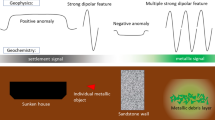Abstract
Fuson (1969), see also Carlson (1975), claims that Olmécs and Maya knew and used a (lodestone) compass for the orientation of pyramids, ceremonial and other important buildings, thousand years before Chinese. This hypothesis is tested here with the aid of the new data, namely by comparison of paleomagnetic declinations for that time and area (Korte and Bőhnel, 2005), with orientation data of buildings based also on our measurements at many archaeological localities of México, Guatemala, and in Copán in Honduras by GPS and with a precise compass. After eliminating known astronomical and calendar orientation of some structures, we have found that there is majority of structures with an orientation that clearly deviates from geographic north (pole of rotation of the Earth). When trying to explain this, we can rule out pure chance, local topography, aesthetic, meteorological or defense reasons. Thus, the Fuson hypothesis can still explain the observed site layout and building orientations. But more accurate and extensive information mainly from paleomagnetism and archaeology is needed to reject or accept the hypothesis. A proof of knowledge of a compass in Mesoamerica prior to Chinese would be important for our understanding history of the ancient world.
Similar content being viewed by others
References
Aveni A.F., 1980. Skywatchers of Ancient México. Univ. Texas Press, Austin and London.
Böhnel H. and Molina-Garza R., 2002. Secular variation in México during the last 40,000 years. Phys. Earth Planet Int., 133, 99–109.
Böhm B. and Böhm V., 1999. The Dresden Codex: the Book of Mayan Astronomy. America Antiqua III, Flemish Inst. for American Cultures, Yearbook 1999 (http://www.volny.cz/paib/dresden_codex.htm).
Carlson J.B., 1975. Lodestone compass: Chinese or Olmec primacy? Science, 189, 753–760.
Creer K.M. and Tucholka P., 1982. The shape of the geomagnetic field through the last 8,500 years over part of Northern Hemisphere. J. Geophys., 51, 188–198.
Creer K.M., 1988. Geomagnetic field and radiocarbon activity through Holocene time. In: F.R. Stephenson and A.W. Wolfendale (Eds.), Secular Solar and Geomagnetic Variations in the Last 10.000 Years. NATO Science Series C, 236, Kluwer Acad. Publ., Dordrecht, Boston, 381–397.
Fuson R.H., 1969. The orientation of Mayan ceremonial centers. Annals of the Association of American Geographers, 59, 494–511.
Hagstrum J.T. and Champion D.E., 2002. A Holocene paleosecular variation record from 14C-dated volcanic rocks in western North America. J. Geophys. Res., 107(B1), 10.1029.
Hongre L., Hulot G. and Kholkhov A., 1998: An analysis of the geomagnetic field over the past 2000 years. Phys. Earth Planet. Int., 106, 311–335.
Klokočník J. and Vítek F., 2005. Astronomical and Non-Astronomical Orientation of Important Ancient Structures of Mesoamerica and Other Remarkablenesses from our Journey to México, Guatemala and Honduras During Spring 2005. Preprint #208, Astronom. Inst. Czech Acad. Sci., Ondřejov, Czech Rep., 117 pp.
Korte M., Genevey A., Constable C.G., Frank U. and Schnepp E., 2005: Continuous geomagnetic field models for the past 7 millenia. Geochem. Geophys. Geosyst., 6, doi: 10.10.1029/2004GC000800.
Knowlton T., 2003: Seasonal implications of Maya eclipse and rain iconography in the Dresden Codex. J. Hist. Astron., 34, 291–303.
Longhen M, 1998. Ancient México. White Star Publishers, Czech Edition Rebo, pp. 292.
Malmström V.H., 1976. Knowledge of magnetism in pre-Columbian Mesoamerica. Nature, 259, 390–391.
Malmström V.H., 1978. A reconstruction of the chronology of Mesoamerican calendar systems. J. Hist. Astron., 9, 105–116.
McElhinny M.W. and McFadden P.L., 2000. Paleomagnetism, Continents and Oceans. Academic Press, London, U.K.
Morley S.G., 1956. The Ancient Maya, Stanford University Press, Stanford, USA.
Ohno M. and Hamano Y., 1992. Geomagnetic poles over the past 10,000 years. Geophys. Res. Lett., 19, 1715–1718.
Thompson J.E., 1935. Maya chronology: the correlation question. Contributions to American Archaeology, 14, 55–102.
Verbelen F., 2001. Eclipse cycles and the pages 51 to 58 of the Dresden Codex. America Antiqua III, Flemish Inst. for American Cultures, Jaarboek Annales 2000, 49–55.
Vollemaere A.L., 1994. Please, forget the GMT correlation! America Antiqua, http://users.skynet.be/fa039055/forgtgtm.htm.
Withmore T.J., Brenner M., Curtis J.H., Dahliny B.H. and Leyden B.W., 1996. Holocene Climate and human influences on lakes of the Yucatan, México: an interdisciplinary paleolimnological approach. The Holocene, 6, 273–287.
Author information
Authors and Affiliations
Additional information
jklokocn@asu.cas.cz
kost@fsv.cvut.cz
ttc.praha@iol.cz
Rights and permissions
About this article
Cite this article
Klokočník, J., Kostelecký, J. & Vítek, F. Pyramids and ceremonial centers in mesoamerica: Were they oriented using a magnetic compass?. Stud Geophys Geod 51, 515–533 (2007). https://doi.org/10.1007/s11200-007-0030-7
Received:
Revised:
Accepted:
Issue Date:
DOI: https://doi.org/10.1007/s11200-007-0030-7




